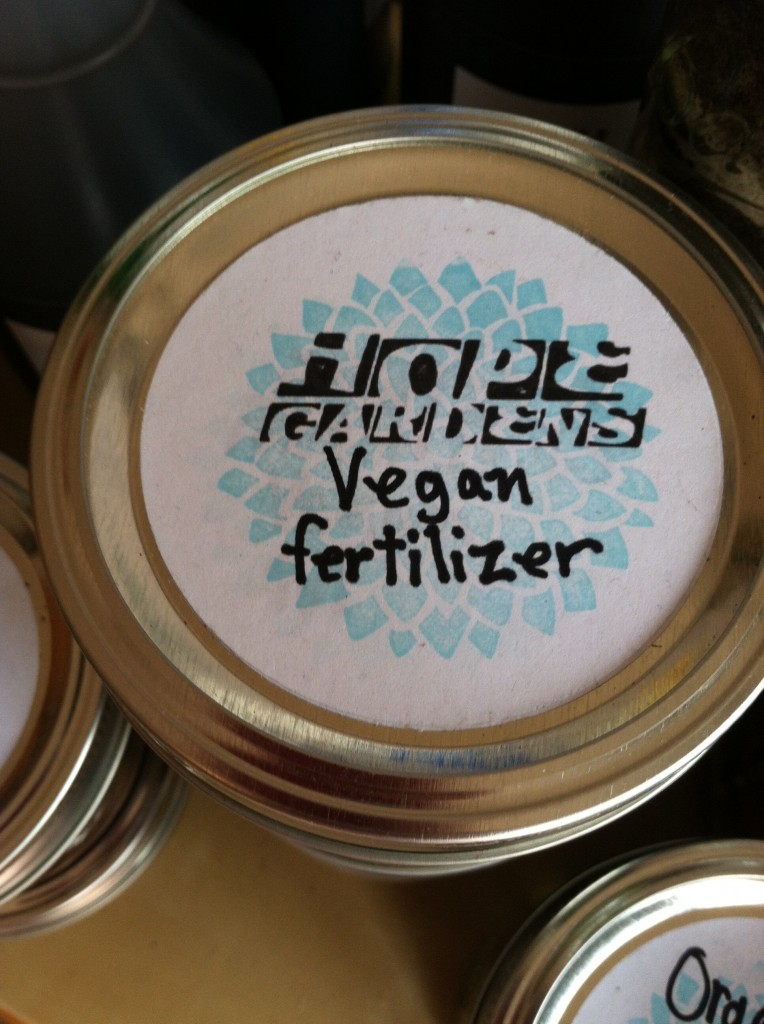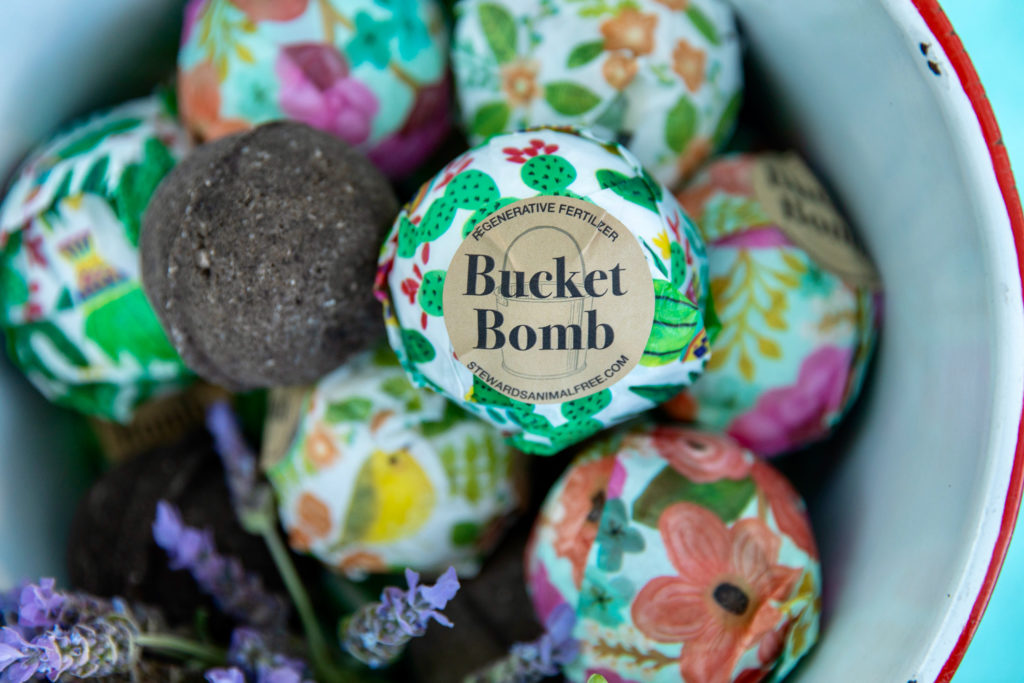

Hi friends! I was sued by a pesticide company of all things for using the word Stewards in regards to fertilizers. This is part of the trademark process and we aren’t going to fight the man on this one. I have changed the name to Cabbage Hill Fertilizer Co. More info and updated photos soon!

Introducing Cabbage Hill Fertilizer Co.! I have been researching organic fertilizers for over ten years and I’m proud to bring you the best organic, regenerative fertilizers for your garden. And perhaps best of all, they are animal-free. Organic fertilizers have had a long and sad reliance on factory farms and slaughterhouses and I could not be a part of that story. That’s not what organic means to me or my clients or the children I teach in school gardens or the community members I serve fighting for food justice.
Animal cruelty plays no part in my gardens and I want you to have that option as well.
DRY TIME-RELEASE FERTILIZERS
Cabbage Hill Fertilizer Co. animal-free, all-natural garden fertilizers can be used on new gardens or existing ones. Our all-purpose fertilizer contains a balance of nitrogen, phosphorous, potassium, calcium, magnesium, sulfur along with many other trace minerals. We add mycorrhizae and fulvic and humic acids to encourage microbiological life. And it’s all animal-free. Synthesizing ancient forms of fertilizing as well as cutting-edge modern techniques, Cabbge Hill Fertilizer Co. fertilizers are safer than traditional fertilizers and provide more nutrition to your plants and soil without any need for animal by-products or manures, keeping us out of the factory farm and slaughterhouse game.

Our All-Purpose Fertilizer has no added pH controls and so is intended for a balanced pH- to alkaline pH-loving plant. Our Vegetable Fertilizer has increased calcium to keep soils more alkaline over time and to support tomato plants specifically. We also add additional potash for all our fruiting friends. Our Acid Fertilizer has all the wonderful attributes as our Vegetable Fertilizer but we have added sulfur and cottonseed meal to give your acid-loving plants a lower pH.
General recommendations are to use around 5lbs of organic/natural fertilizer for 100 square feet but I like to fertilize at a much higher rate. I use 2 – 3 lbs (4 – 6 cups) in my new raised beds which are 32 square feet. You may also want to take into account any compost or worm castings you are using. Those bring nitrogen to the garden so you may can pull back on your fertilizer a bit if you also use these products.
In general, new gardens will need more fertilizer than existing gardens. New garden soil should be started with some mix of potting soil, compost, worm castings, soaked coir, peat, perlite and/or vermiculite. Some folks like to add wood chips and lava rocks as well. Your mix will depend on your budget, availability of materials, what kind of garden you are starting and how much bandwidth you have for this stuff. I started my first garden with a bag of potting soil and some pre-mixed organic fertilizer and that’s it. I didn’t even know what any of that other stuff was. The important thing is to get started. Because, guess what? One of the best ways to feed your soil is to plant in it.

The very act of organic gardening creates life in your soil. The roots of growing plants make their own bacteria, store carbon, convert nitrogen and support other life forms; thereby building soil.
(In contrast, soil in a non-organic garden can become severely depleted with each planting and synthetic or chemical fertilizers can contaminate a soil over time. Maybe this situation is what drives the myth that soil should “rest.”)
So don’t wait till conditions are perfect. Start with what you have. My minimum recommendations are the Big Three: a bag of potting soil, some compost and organic fertilizer.
You should be planting all year if possible and if not, growing a cover crop (fava beans, for example) between plantings. If you have not been growing in your garden for a season, fertilize it as you would a new garden.
Also consider your container when establishing the amount of fertilizer to use. A raised bed that’s 4′ x 8′ and 12″ deep may get 2 lbs of fertilizer but a 25 gallon felt pot I would use 3/4 cup of fertilizer as it’s a stand alone vessel. Basically raise your ratio a bit for smaller containers.
You must also consider season and the type of crop you are growing. I add more fertilizers in spring than in fall, as spring-plantings often mean fruiting plants, think tomatoes and cucumbers, and they are the heaviest feeders. Beware of over-fertilizing root vegetables in the winter, like carrots, as they can respond by growing large green tops but very small roots. And I grow a lot of lettuce and other leafy greens without the need for a large amount of fertilizer. That being said, all of my gardens get a lot of compost which naturally brings a lot of nutrients to the soil. If you are not currently using compost, be more liberal with the fertilizer.

Because these are organic fertilizers there is almost no risk of burning your plants. Plants know how to process and expel these natural materials and will simply discard what nutrients they don’t need. What you are most at risk of is wasting some money but if you’re already a seasoned home gardener, I know that’s not your first concern. 😉
You will need to work your fertilizer through the top 2/3 or your soil and water very, very well. New soil or soil that has been neglected should be soaked for days before you apply the fertilizer and then again watered after. You don’t want to wash the fertilizer away which is why I prefer to water abundantly in advance.
If possible add fertilizer to soil and then wait a few days – or a few weeks even – to plant. This allows the fertilizer to dissolve and activate. I also schedule my fertilizer application away from my application of compost or worms so I don’t accidentally harm my worms with the dry fertilizer or the tossing of the soil. Generally my worms/compost are the last things I add to the garden – after planting even – for minimal disturbance. They can be placed on top of the soil like a mulch and the worms can find their own way into the soil. If birds are very active in your yard as they are in mine, cover your garden lightly with a row cover to protect your precious worms!
And organic fertilizer is not once and done, especially for fruiting plants. Side-dress (add fertilizer loosely into the topsoil alongside plantings) with more dry fertilizer every 4 weeks. At that time, I like to top the fertilizer with some more compost or leaf mold or wood chips. Remember to water well after applying dry fertilizers. Plant roots need the dry fertilizers to dissolve so they can absorb them. You can also add our Vegetable Fertilizer or All-Purpose Fertilizer to your new compost pile as a starter.
Store organic fertilizers carefully, sealing the top shut every time you use it, as moths love to lay their eggs inside fertilizer containers and that is an awful mess.

After extensive research on traditional organic fertilizers, I started field testing vegan fertilizers through my landscaping company, Hope Gardens. The cruelty of traditional animal-based fertilizers honestly horrified me. And liquid fertilizers were no different. There’s little transparency in the realm of organic fertilizer but I had read tales that fish were farmed just to be ground into fish emulsion for fertilizer and I knew there was a better way. After all, liquid fertilizers are a wonderful asset in your garden.
CONCENTRATE FERTILIZERS
Liquid fertilizers are easily accessible to your plants and easy to apply. They can be used every 2 weeks on established seedlings either as a root drench or a foliar spray…although there is debate on the real benefits of foliar application.
Our soluble Concentrates come in a micronized powder rather than a liquid, because after all, why pay for water? And our Concentrates contain more than just the typical seaweed/kelp blend and certainly don’t contain any fish emulsions. Our Concentrates are a balanced fertilizer blend of all the macro- and micro-nutrients present in our dry fertilizers as well as our soluble mycorrhizae and fulvic and humic acids. They come in all three varieties: All-Purpose, Vegetable and Acid.

Add 2 T of our concentrate to 1 gallon of filtered water or rainwater in a bucket or bin. I recommend using a hose filter to filter out chlorine before adding hose water to your garden or your fertilizer. And I LOVE Gorilla Tubs for everything gardening. I probably have a dozen of them in all sizes!
My favorite way of applying liquid fertilizer is from a watering can so the stream is gentle. Did you know the attachment at the end of a watering can spout is called a rose? How great is that? And that rose attachment helps deliver a gentle or fine spray to your root systems and leaves. Some gardeners will also use a smooth stone on the surface of the soil and water directly on the stone to dilute the harsh stream of water from a hose or watering can. This helps prevent root damage or erosion. We are here to help our plants, not hurt them.
BUCKET BOMBS™
And introducing our very own invention, the patent-pending, innovative and adorable fertilizer delivery method known as the BUCKET BOMB™.

Bucket Bombs™ are self-diluting, pre-measured fertilizer concentrates suspended in fizzy bubbly wonderfully-smelling balls. Drop the Bucket Bomb™ in filtered water and it bubbles into the perfect fertilizer. This is the greatest gardening gift and comes in beautiful packaging.

Our fertilizer bombs come in All-Purpose, Vegetable and Acid like the rest of our fertilizers. Once the bomb has finished dissolving, you can dilute it.
The liquid can be diluted at a rate from 2:1 to 5:1 depending on how many plants or containers you want to fertilize. You can pour it as a root drench from the bucket or use in a watering can. We recommend not using the liquid in a sprayer.
My favorite gardening quote is this:
so please remember to get out in your garden often, enjoy your garden and share your harvests. Fertilize ethically, thoughtfully and productively with Cabbage Hill Fertilizer Co.
